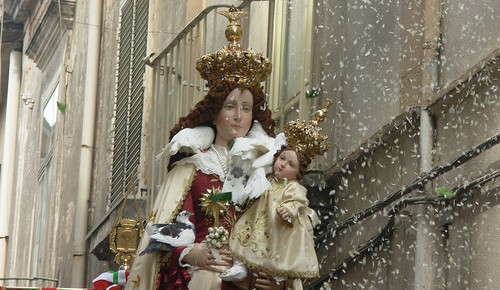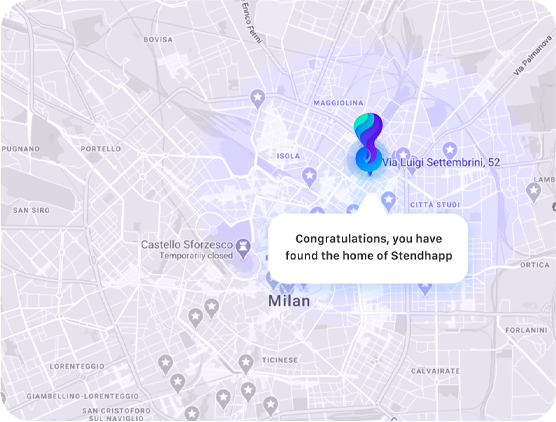Have you ever wondered what Italy’s artistic heritage would be without the contribution of the Catholic Church? Here at Stendhapp, we asked ourselves that question and queried our database-the numbers that came out really made us jump in our chairs.
On our map there are more than 31,500 churches. Not all of them are noteworthy from the point of view of architecture and the works of art they contain, but certainly most of them are spectacular and filled with masterpieces. Regardless of the religious aspects-which are not the subject of this research-it remains a fact that the strong Catholic faith of the Italians and the presence of the Vatican have been instrumental in making Italy what we see today, the country of Beauty.
More than 9,000 Italian churches are dedicated to the Virgin. There are more than 1,500 Marian shrines alone, the places with a name linked to the cult of Mary are a whopping 2,133, a sign of a very strong devotion that runs through the country, unbroken.
We thought to tell the story of some of the shrines dedicated to Our Lady, not necessarily the most famous ones, we have chosen some places of Marian worship unknown to most, instead, whose name aroused our curiosity.
Madonna della Gamba – Albino (BG)
That Our Lady was a fine woman there is no shadow of doubt, but the origin of this Baroque shrine in the province of Bergamo is quite peculiar. It recounts an event from 1440, the healing of little Venturina Bonelli, a 12-year-old girl who was in danger of having her left leg amputated due to gangrene. The mother and child were weeping at the altar dedicated to Our Lady in the parish church when the Virgin appeared to little Venturina and healed her leg. Over the centuries the little girl’s room became a place of worship, and around 1740 the Baroque shrine was built, whose crypt is exactly the little girl’s room where the apparition took place.
Beata Vergine della Scopa – Osio Sopra (BG)
Since the 12th century where the shrine dedicated to Our Lady of the Broom now stands, there was a little country chapel dedicated to Mary. The place, in the open fields, was frequented by peasants and wayfarers and at one point…. was really dirty! It is said that at this point, Our Lady herself, in her Queen of Heaven robes, showed up with a broom and cleaned the chapel. Following the pastoral visit of St. Charles Borromeo in 1566, the modest chapel was transformed into a shrine. In the early 1900s, the renovation of the shrine was entrusted to architect Virginio Muzio, the father of the more famous architect Giovanni, an exponent of the traditionalist current-that of the Triennale and the Ca’ Brutta in Milan.
Madonna della Noce – Inverigo (CO)
The Sanctuary of the Madonna della Noce was born from a story of 1501: 2 children who, having got lost in the Inverigo woodlands, were rescued by the Virgin Mary who appeared to them with the Child above a walnut tree. In 1519 the construction of a small stone church was begun then, at the request of the unstoppable St. Charles Borromeo, a shrine and seminary were planned in 1582 to train the priests of the area. But when Cardinal Federico Borromeo’s nephew visited Inverigo 25 years later, he realized that the shrine had not yet been built! They were too poor-in fact, the actual shrine dates back to 1670.
Madonna della Castagna – Bergamo
To know the history of this shrine we have to go back to April 28, 1310, when Our Lady appeared to a peasant expressly asking to build a chapel dedicated to her. Exactly 200 years later, on April 28, 1510, Our Lady showed up again and appeared to two men, who were gathering leaves for the animals, again asking to build a shrine dedicated to her. There was a large chestnut plant on the site, and suddenly the still unripe fruit became ripe and good. At this point there were no more excuses: the foundation stone was laid in 1515, and the shrine took on its present appearance in the late 1800s.
Madonna dello Schiavo – Carloforte (CA)
Here the legend, dating back to the late 1700s, tells of an inhabitant of Carloforte who, having been enslaved during a Saracen assault, had been taken to Africa. The man, on the morning of November 15, 1800 on the beach at Nabeul in Tunisia, had picked up part of the figurehead of a ship on which a Madonna was carved. Once freed, thanks to a substantial payment from King Charles Emmanuel IV of Savoy, he brought the statue home to Carloforte. Imagine the journey with such hand luggage… To accommodate the statue, the nineteenth-century church of the “Madonna of the Slave” was built in the center of the village of Carloforte, and every year on November 15 a festival is held with a procession through the streets of the village.
Madonna di Gulfi – Chiaramonte Gulfi (RG)
To discover the history of this shrine, we have to go to Constantinople in the 4th century AD: according to legend, a statue of the Madonna and Child and a statue of the Savior landed on the beach between Scoglitti and Santa Croce Camerina after escaping iconoclastic persecution. The inhabitants of the area, who disputed the two statues, according to a custom that recurs in various parts of Italy, settled the dispute by placing them on two ox-drawn wagons, thus leaving it up to the animals to choose the site to which the sacred images should belong. The wagon carrying the statue of the Virgin stopped near Gulfi, where the shrine was erected. Around the year 580, St. Gregory the Great, before he became pope, also visited the shrine and, kneeling down, it is said that he left the imprint of his knee on a step. The church as we see it today dates back to the 1700s. Every year, during the Sunday in Albis (the first Sunday after Easter) the citizens carry the statue of the Virgin on their shoulders from the Sanctuary to the Mother Church of the village; this procession is carried out at a run, and sees numerous bearers lift the enormous statue of the Virgin and hoist it, aided and pushed by the faithful, up the slope that goes from the Sanctuary to the village of Chiaramonte.
Madonna delle Galline – Pagani (SA)
In the 16th century it was chickens, scratching around, that brought to light a wooden tablet on which Our Lady of Mount Carmel was depicted. The tablet was initially kept in a dressing room inside the ancient parish of San Felice. And there it would probably have remained, except that in 1809, a cripple who had fallen asleep in the dressing room saw in his sleep Our Lady inviting him to get up and throw away his crutches because he was healed. The miracle had a great echo and was only the first in a long series.
In 1610 it was then decided to build a church to welcome the faithful on pilgrimage, on the very spot where the chickens had found the tablet. The sanctuary was gradually embellished and today sports a splendid Baroque facade.
On Sunday in albis there is a procession of the statue of Our Lady of Mount Carmel transported on a cart pushed by the faithful to whom people offer various birds, mainly chickens, of course, and also sweets and rustic cakes. Along the procession route, the faithful create “toselli,” votive shrines embellished with satin blankets, lace and terracotta molds, and small chicken coops. But the main feature is the “tammurriata,” frenzied folk music that until dawn the following Monday accompanies the festivities of the faithful and … the feathered ones.
Madonna del Pettoruto – San Sosti (CZ)
Madonna del Pettoruto is located 543 meters above sea level in the gorge formed by the Rosa River between Mount Montea and Mount Mula. The name derives from “petruto,” stony, and again there is a legend to tell. In the 15th century an inhabitant of Altomonte, Nicola Mairo, falsely accused of murder, took refuge on Mount Montea to escape capture. While there in solitude, following a mystical vision, he decided to carve a Madonna and Child on the rock, and in 1449 Mairo was exonerated. When 150 years later, a deaf-mute shepherd discovered the image carved in the rock while searching through the woods for one of his sheep, he miraculously began to speak: the Virgin had given him the gift of speech to enable him to reveal the miraculous place to all and have a shrine built and dedicated to her.
However, it took about 200 years to build the shrine of Our Lady of the Pettoruto, which did not see the light until 1849. From that year on, her devotees have taken the cult of Our Lady of Pettoruto all over the world, from Argentina to the United States and even Canada: it is the only Marian shrine in the world to be twinned with the Shrine of Our Lady of Fatima.
Santuario della Madonna del Fulmine – Massa d’Albe (AQ)
It all began with an unknown painter, probably from Tuscany, who painted a fresco in 1450: it depicted the Madonna and Child. In the second part of the 15th century the church of Santa Maria was built around the fresco. Later by papal decree Santa Maria was crowned-hence the name of the church and the entire village, which was named Corona.
The 18th century opened with two terrible earthquakes with epicenter in Abruzzo: the church was damaged and in the reconstruction the fresco of Our Lady of the Crowned was covered by plaster and remained hidden until the end of 1700. On June 8, 1785, a small cloud appeared in the almost clear late spring sky, which grew to generate a drizzle, followed by a loud clap of thunder and lightning that struck the church. Incredibly, the lightning avoided the bell tower-despite the metal of the bells, it did not strike the parish priest or the sacristan-but a canvas depicting St. John the Baptist, which, as it fell to the ground, uncovered the fresco of Our Lady under the plaster. From then on, the church took the name Sanctuary of Our Lady of Lightning. In 1915 a new earthquake caused the church to collapse, but the wall with the fresco of crowned Mary miraculously remained intact, and the beautiful 15th-century fresco is still visible today.
Madonna delle Armi – Cerchiara di Calabria (CZ)
Fortunately, weapons have nothing to do with it; we can continue to rely on Mary to protect us from wars and violence. The name comes from the Greek “armon” meaning “caves,” the caves of Mount Sellaro, also known as Monte Santo. The church was built on an ancient Byzantine monastic site, known since the 10th century.
Legend has it that some Rossano hunters saw a doe hiding in a small cave on Mount Sellaro. They followed it, but inside they found not the doe, but two wooden icons depicting the evangelist saints. The hunters, amazed at the prodigy, took the icons to Rossano, but the tablets repeatedly disappeared, only to be found again and again in the cave where they had been discovered. It was then decided to build a chapel there to keep them since there was no way to keep them in Rossano. During the work, a blacksmith unnerved by an oval stone that continually happened to be in his hands, broke it with a firm blow. The stone split open in two: on one side was the image of Our Lady with Child and on the other side St. John the Baptist. The image of the Virgin is still kept in a chapel inside the church; the other was stolen and, it is said, transported to Malta.
Photo from Wikipedia





